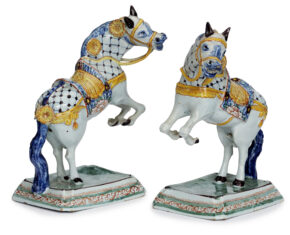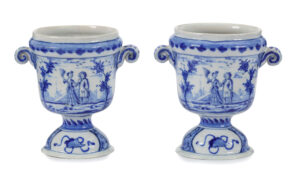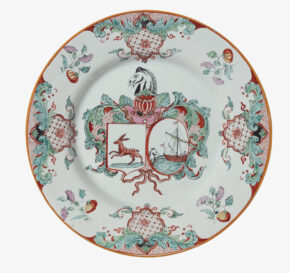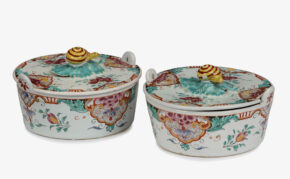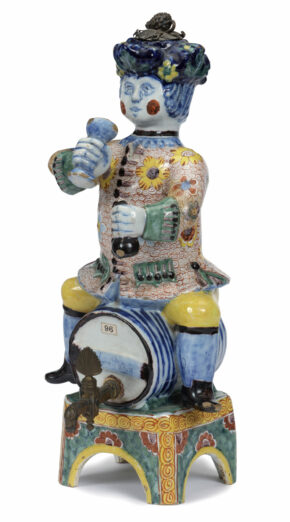![]()
Images on this website are licensed under a
Creative Commons Attribution-NoDerivs 3.0 Unported License.
OBJECT
D2418. Cashmere Teapot and Cover
Delft, circa 1710
Marked LVE 05 A in blue on the base for Lambertus van Eenhoorn, the owner of De Metaale Pot (The Metal Pot) factory from 1691 to 1721, or his widow Margaretha Teckmann until 1724
The fluted spherical body is adorned in the cashmere palette, featuring hues of blue, green, yellow and iron-red, decorated on either side with a laurel wreath with C-volutes, flowers, and branches, flanked by oval-shaped garland medallions portraying a garden urn filled with flowers, the cover exhibits floral patterns, and the knop is shaped as a lion, the spout featuring a mythical beast emerging from the open mouth, a later silver chain is affixed to both the cover and the angular handle and the foot finished with a meander band.
DIMENSIONS
Height: 12 cm. (4.7 inch)
PROVENANCE
Sold at Frederik Muller & Cie, Amsterdam, May 9-11, 1933, lot 397
NOTE
Initially, tea was consumed for medicinal purposes in Europe, since it “suivert het grove bloedt, verdrijft de sware droomen, (…) ’t verjaegt de dommigheijt en ’t sterckt Venus’ handel (gedienstig voor nieuw getrouwde)” (“purifies coarse blood, drives out heavy dreams, (…) chases away stupidity and strengthens Venus’ affairs (useful for newly weds)”. Eventually, the craze for tea drinking swept through Europe in the last quarter of the seventeenth century.
Once the practice became fashionable, it changed the rhythm of people’s daily lives. Tea could be drunk once or twice a day, but afternoon gatherings became the new habit. Furthermore, it inspired people to acquire the necessary accoutrements for serving the drink. In the seventeenth century, these necessities could be of a variety of materials, and even a combination of Chinese and European tea wares.
However, by the end of the eighteenth century, it was customary to have complete matching sets. Tea was presented to guests in beautiful tea canisters, and then strongly brewed in small pots. These concentrated brews were then diluted with hot water from a bouilloire, a silver, copper (although this material was thought not so suitable for boiling water) or pewter kettle on a stand over a brazier. Bouilloires were also executed in Delftware, but they are very rare. When the guest wanted to try a different kind of tea, he or she could rinse the cup in the slop bowl. The new drink was served as hot as possible, but if too hot, it could be poured on the saucer to cool a little and sipped from there. With tea being very expensive, the cups were small, so it was not uncommon if one would have up to twenty or even fifty cups during a tea party.
Dutch Delftware teapots are rare, since vessels made from regular earthenware were comparably coarser than porcelain, and considered less elegant and pleasant to drink from. Further, earthenware is not the best material to hold boiling water. Earthenware, which is more porous than porcelain, conducts heat more easily. It was thus more prone to crack when it had to endure large temperature differences. If the glaze crackled, the material underneath became unsealed, and the water caused it to crumble.
The delicate grand feu decoration on this teapot was given the descriptive title ‘cashmere’ for its likeness in color, and exotic, dense motifs to the fine woolen shawls that were imported from India and worn by high-class European ladies. The earthenware of this category has a color scheme of blue, red and green. Although the Delft pieces were named after the fashionable textiles, the Delft potters were in fact inspired by the Chinese famille verte porcelain wares of the Kangxi period (1662-1722), which arrived in Europe at the end of the seventeenth century. Since the production of these pieces was probably too expensive, the cashmere palette enjoyed a brief, yet widespread success during the first half of the eighteenth century.


